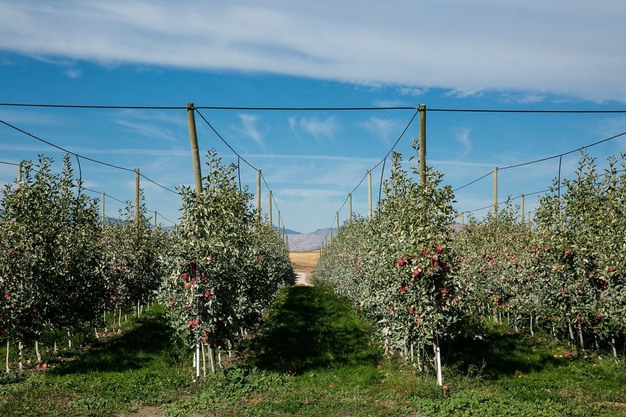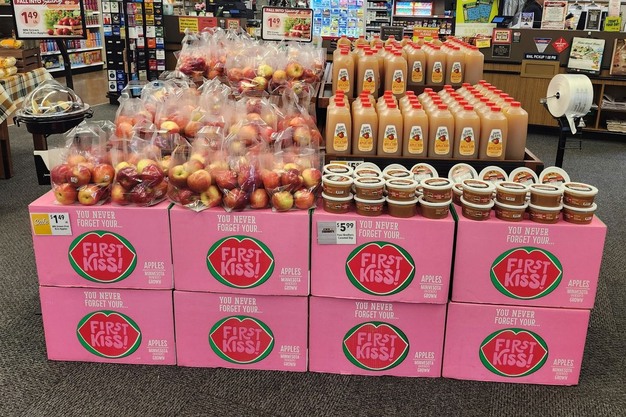The initial estimate of the Washington apple crop came out at 140 million cases, an all-time high. Since then, the number has been adjusted slightly downward, but the crop still has the potential to be the largest on record. The main reason the total crop may come in under estimate is because growers are becoming increasingly mindful of the fruit they are picking. For the past several seasons, apples have been lossmaking and with harvesting labor and agricultural input costs continuing to increase, growers are being forced to make choices. "Increasingly, they decide to focus on mitigating costs, for example targeting one round of picking, skipping the second and third pick," says Don Roper with Honeybear Marketing. "As a result, some fruit is left on the trees. The reality is that it is cheaper to walk away from it than go back into the orchards, for a limited amount of fruit."
Right now, harvest is centered around two of the main six apple varieties in the state. All Galas are in the barn, and their total harvest came in about 10 percent under estimate. Warm weather slowed down the growth and some of the sizing. "The crop is peaking on 100 ct., which is the standard size for Gala," shared Roper. Most growers are leaving the small 2 ¼ inch fruit on the trees. "It just wasn't worth picking it because this fruit is smaller than the size required for most retail bag programs, limiting the demand."
 © Honeybear Marketing
© Honeybear Marketing
Varieties discussed in more detail
Harvest of the Honeycrisp variety is over halfway done and with approximately 20MM cases, the crop is expected to come close to original estimate. Harvest of the Granny Smith and Red Delicious varieties is starting now, and Fuji will be right behind. The volume of Granny Smith is expected to be record breaking this season. The fruit size is large and as a result, the price of XL fruit - 56 and 48 ct. - and blush Granny Smiths will be soft. There is a concern with Fujis as the crop is expected to peak smaller than normal, at least one size if not two sizes down. "We certainly wish they were bigger, but weather slowed down their growth," commented Roper. Not only did weather slow down the size, the variety is also lacking some color. "With a couple more weeks before full harvest of Fujis, we are hopeful we will see more color and size in the final pack."
The Cosmic Crisp and Cripps Pink varieties are several weeks away from harvest. While all indicators point towards a good crop, the window until harvest is still long.
 © Honeybear Marketing
© Honeybear Marketing
Balanced crop in Northern Washington
Zooming in on the growing conditions in Washington state, about two thirds of volume is grown in the southern part of the state, the Columbia Basin. In recent weeks, the crop had to endure warm weather and a fair amount of smoke from forest fires, which caused coloring issues. "The situation is just starting to turn, and we expect cooler days and cooler nights in the coming weeks." Daytime temperatures around 77°F and nighttime temperatures of 44°F are ideal coloring weather. "We hope the cooler weather will help finish off the coloring," Roper said. In the Northern part of the state on the other hand, growing conditions were different. While the sizing might be down a bit, the region is experiencing a very nice quality apple crop with really strong color. Historically, the northern region has been the cooler region, resulting in stronger colored fruit.
Sizing is down in Michigan
Michigan also plays an important role in U.S. apple production, expecting a crop size between 26and 30 million bushels. The state is tracking to see a crop reduction of about 10 percent versus last year's crop. While coloring looks good, the size of the fruit is down one to two sizes in the Midwest. As a result, a lot of fruit is expected to go in bags and retailers will look at options to size down on their bulk apple offerings.
The East Coast, with New York being the main growing state, is looking at a crop of 28 – 30 million bushels or about 5 to 10 percent smaller than last year The Gala harvest is coming in a size or two smaller than last year, so there will be a lot of volume of medium and small-sized fruit. Honeycrisp is in the middle of harvest and right now, current estimates are being met. "Overall, the East has experienced a very good growing year, and we are seeing fruit with very good condition, high color and high brix." Due to the large population in that part of the country, nearly all the apples will be marketed in the East stretching from the Northeast all the way down to the South and Southeast. Much like the Midwest, the Eastern apple production generates a lot of consumer excitement as there is a strong affinity and preference for locally grown apples. While nearly all apple varieties are also grown in the Midwest and Eastern apple production regions, several varieties including Cosmic Crisp, Granny Smith and organic apples are brought in from Washington. Some of this has to do with growing rights for specific varieties and some varieties just grow better in the Pacific Northwest due to the climate which really lends itself to growing organic varieties.
 © Honeybear Marketing
© Honeybear Marketing
Next month, Honeybear will be exhibiting at IFPA's Global Show in Anaheim. Visit the company at booth #1539.
 For more information:
For more information:
Don Roper
Honeybear Brands
[email protected]
www.honeybearbrands.com
